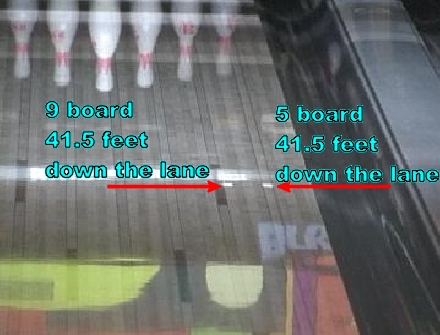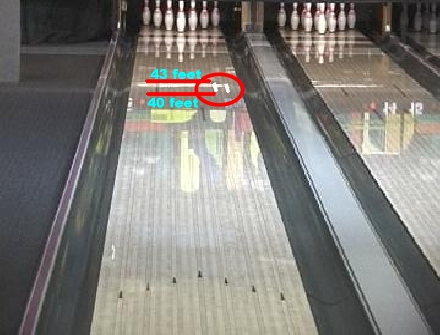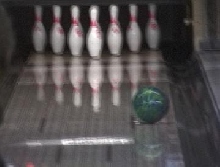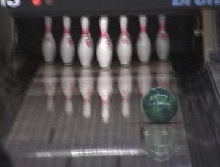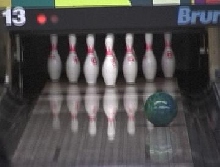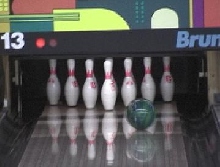Breakpoints and Drawing Lines on the Lane
( Part 1 )
by Ron Clifton
When I say breakpoint, I am not talking
about the moment you left just one too many 10-pins and decided throw all your balls
in the river. I am talking about a spot down the lane where the ball starts to
hook toward the head pin. If you tend to throw the ball pretty straight or maybe
only hook it 4 or 5-boards, this will not matter as much to you; but if you hook the ball more, then you need to learn about breakpoints.
Learning how to use your breakpoint can help you in
many ways. It can help you play the lane in a way that produces the most
strikes. It can tell you if it's the lane condition that is keeping you
from getting strikes or if you are actually throwing the ball badly. This last
point in many ways is the most important: I have seen many bowlers
complain because they are not getting strikes; yet they are missing their
breakpoint by a zip code.
Using your breakpoint as part of your target line can
simplify the game greatly. Using this method, we can shorten a 60 foot lane to
only 20 feet. That's because our break point is going to be 40 to 45 feet down
the lane in most cases. If you learned to bowl before the advent of reactive
resin hook monster balls, then maybe you have never even heard of using your
breakpoint as part of a targeting system. When Mark Roth was setting the pro
tour on fire in the 1970's, his plastic yellow dot ball made a long sweeping
arc toward the pocket. The shape of today's ball paths look much different.
Today's balls go pretty much straight for a long distance, then turn sharply
toward the pocket. Even balls and drillings that are called
"arching" layouts still fit into this category. This is mostly
due to the slickness of today's oil and to the design of today's balls.
The shape of the ball path today looks like a long straight
line about 40 feet in length with a sharp turn toward the head pin.
This sharp turn is called the breakpoint. The breakpoint is not actually a
single point on the lane, but we treat it as such. Some balls indeed can go
across the lane passing over the 4th arrow and out to the 7-board, 42 feet
down the lane and just turn sharply toward the head pin. Other balls
thrown will travel the same path and maybe hit the 7-board at the 40 foot mark
and actually reach an equilibrium, riding on that 7-board for 3 or 4 feet then
turning toward the pocket. This riding of the 7 board for three feet will not likely be
noticed by the naked eye unless you really look for it. I do a lot of coaching
using a good digital video camera and I can zoom in on the ball like it was
three
feet in front of me.
|
In
the photos below, I placed pieces of tape on the 5-board and the 9-board,
41.5 feet down the lane. The lower dark marks on these Brunswick lanes are
preprinted and start at 40 feet and end at 43 feet. They are placed on the
10-board on each side. When you throw your ball, this is the area where the
ball will hook. The area between the two pieces of tape represents the area
of the lane where your breakpoint will have the best chance of striking.
|
So how do you find your breakpoint? This is easier on
some lanes than others. If you happen to be lucky enough to bowl on the
"Brunswick Anvilane Pro Lane" there are breakpoint markers
printed right on the lane, 40 feet down, to help you out. This is the type of lane
I coach on at Creekside Lanes. It makes it much easier for a student to see his
breakpoint and catch on to the idea of how to use it. Some synthetic
lanes have light and dark boards which can help you pick out where the ball is.
The hardest lanes to work with are the synthetic ones where every board is the
same color. If you bowl on wood lanes, there are usually light and dark boards
down the lane that will help you judge where the ball is. To find your
breakpoint, simply throw the ball from an inside shot and watch it go down the
lane. Try to see where on the lane the ball stops going toward the gutter and
starts to turn toward the head pin. The first thing you have to learn is to
notice how far down the lane the ball is going. We don't have to know the actual
number of feet, but we do need to learn how far to look down the lane to expect the
ball to hook. You will find that your breakpoint distance will be about
the same everywhere you bowl. Yes, if there is an extremely short or long oil
pattern or if the oil has been mostly depleted, your distance will change a
little, but in most cases your ball's breakpoint will be within two or three feet of
the same distance from the foul line.
Now that you can see about how far down the lane the ball is
going, try to notice what board the ball actually starts to hook
on at the breakpoint. First, try to pick out the 10-board and the 5-board as reference points down the lane where your breakpoint
lies. When you are first
learning to use your breakpoint, try to learn to notice if you are keeping the
ball between the 10-board and the 5-board each time. Practice watching your ball
from the time it crosses your mark at the arrows all the way to the breakpoint,
making note each time where the ball breaks . Notice I am not saying use your
breakpoint as your target to look at. Use your normal target to look at, and
simply follow the ball all the way down the lane with your eyes. Don't get in a
hurry and look up toward your breakpoint trying to beat the ball down there; just watch the ball roll.
Next month I will go into more detail about the
breakpoint and how to use it in a targeting system and of course how to get more
strikes. In the meantime, practice picking up your breakpoint as your ball
rolls down the lane.
I can be contacted through email at rclifton@triad.rr.com
